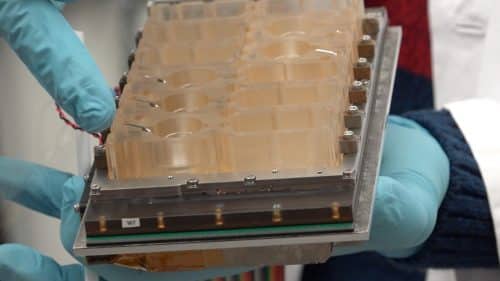Researchers have built a laboratory model that mimics the operation of the female reproductive system

It is not possible to model the exact hormonal signaling that activates the female reproductive system in a flat petri dish. Scientists, trying to address the historical lack of research in the field of women's health and female physiology, have now created the first "organ-on-a-chip" model whose operation recreates the menstrual cycle. This XNUMXD system helps scientists understand some of the causes of repeated miscarriages and may provide material for research in contraception and drug development in other fields. Fertility experts hope to eventually be able to feed a sample of cells from one woman into such a model and thus determine the best treatment for her.
A team led by obstetrician and gynecologist Teresa K. Woodruff of Northwestern University grew human cells and mouse cells from several reproductive organs in a network of interconnected tiny cubes. Tubes, valves and pumps flowed air and fluids through the system in a way that mimics the natural flow of substances in the body. The cells, which in the petri dish were dead, remained alive for 28 days, the length of time of a normal cycle. The researchers stimulated the chemical communication in the system by injecting a hormone from the pituitary gland. The cells, in response, secreted estrogen and progesterone at the levels typical of the menstrual cycle - also during ovulation - and thus restored the signals exchanged between different organs in the female reproductive system. The team was also able to simulate hormonal activity that occurs shortly after conception, thus creating a tool that can provide insights into maintaining a successful pregnancy. the study year degree in Nature Communications.
The system includes mouse ovary cells (which produce the same hormones that a woman's ovaries produce), along with human cells from the fallopian tubes, endometrium and cervix. Human liver cells were also added, because this organ breaks down many drugs. This work builds on many other studies that looked at ways to produce organs on chips as models for the human body.
The new system is still far from being a perfect replacement for the female anatomy: it has neither a placenta, which is necessary for maintaining pregnancy, nor an inflammatory system. Nor can it answer the question of how early exposure to toxins can affect the health of the reproductive system, says Kevin J. Austin, a professor of obstetrics and gynecology at Vanderbilt University School of Medicine, who was not involved in the study. But Woodruff says the work her team has done will enable new research into a wide range of medical problems, including cervical diseases, which cannot be studied using rodent models because of differences at the cellular level.

2 תגובות
To Judah:
Fertility experts hope that they will eventually be able to feed a sample of cells from one woman into such a model and thus determine the best treatment for her.
The important sentence in the article: "The new system is still far from being a perfect replacement for the female anatomy." End quote. What is the use of such a system? What can't a simple application or software replace it? The article and the chip in question raise more questions than they are supposed to solve.
Good night
Yehuda